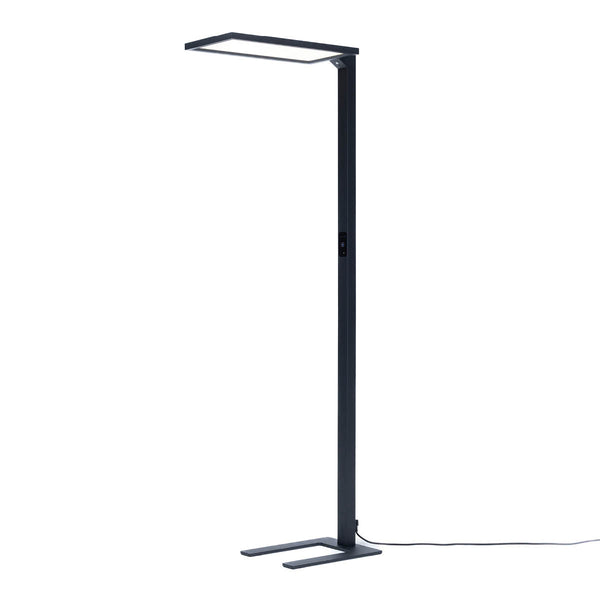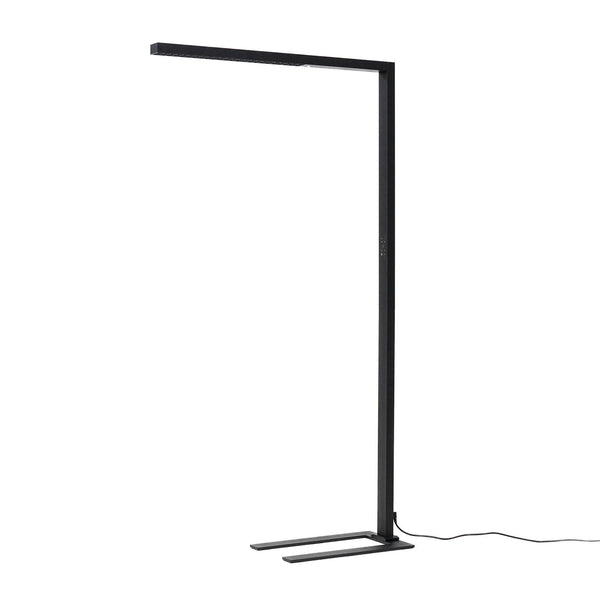Workplace lighting: how to work healthier and more effectively
Whirring fluorescent tubes, flickering light, a sterile lighting atmosphere - when it comes to lighting in the workplace, there's a lot you can do wrong. And this despite the fact that the light we expose our bodies to every day plays a key role when it comes to our well-being. That is why there are also various requirements under labor lawthat clearly define what needs to be taken into account. In this blog post, you can find out what you need to pay attention to when it comes to light and lighting in the workplace!

Why is the right workplace lighting so important?
How comfortable we feel and how efficient we are depends to a large extent on how bright it is. Sufficient Adequate, high-quality lighting at the workplace therefore plays a major role when it comes to our physical and mental well-being and concentration at work.
The importance of light is due to the fact that our body adjusts to the rhythm of the day and night. Depending on how much and what kind of light we are exposed to, certain hormones are released. When it is dark, the body produces melatonin, which puts us into a resting stateBlood pressure drops, bodily functions slow down and we become tired. In contrast, the hormone serotonin is mainly active during the day and helps to keep us alert and active.
Apart from the fact that we stay awake and active with the right lighting, there are 3 other reasons why the right light in the workplace is so important:
1. you protect your eyes with the right light in the workplace
Your eyes are in constant use every day, processing countless visual stimuli. The wrong light at the workplace can overstrain them, be it through excessive brightness, excessive colors or excessive contrasts. Protect your eyes by using soft but sufficient light that adapts flexibly to you and your surroundings. This keeps your eyes fit and allows them to do their job optimally.
2. The right workplace lighting boosts concentration and increases productivity
Yes, the right light can promote concentration and thus increase productivity.
For good concentration while working, it is important that there are as few disturbances as possible. Dazzling, flickering or bright light can be such a disruptive factor. If our eyes are strained by flickering or too intense light, we find it difficult to concentrate fully on our tasks. This is another reason why it is important to take the issue of light and lighting in the workplace seriously.
The color of light can also have amajor impact on our concentration and productivity. Blue light, for example, increases serotonin production, which makes us alert and attentive. However, blue light should not be used throughout the day, as it can otherwise cause overexertion. In the afternoon and evening, the light can be warmer.
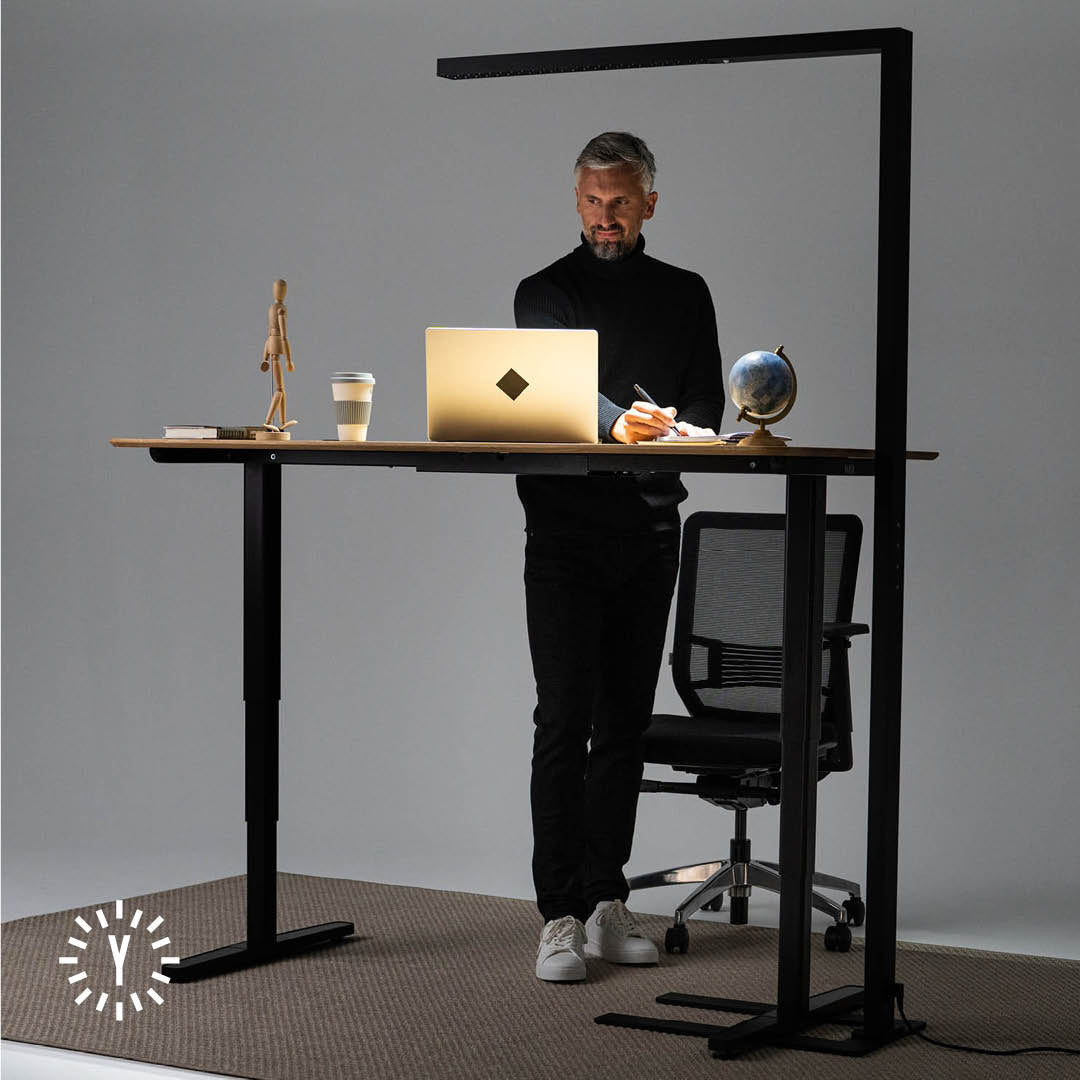
3. prevent headaches with ergonomic lighting at the workplace
Headaches are often your body's first warning signal that something is wrong. Whether you haven't had enough to drink or are overworked, this can manifest itself in a headache. Poor lighting at work can quickly overwhelm you and lead to restlessness. If you want to avoid headaches as much as possible, work with ergonomic lighting. Your head will thank you for it!
Which lighting is best for the office workplace?
Ergonomic lighting at the workplace takes three main factors into account: Light color, light intensity and individual needs. We will now explain why these three points are particularly important and what else you should consider when choosing light for your workplace.
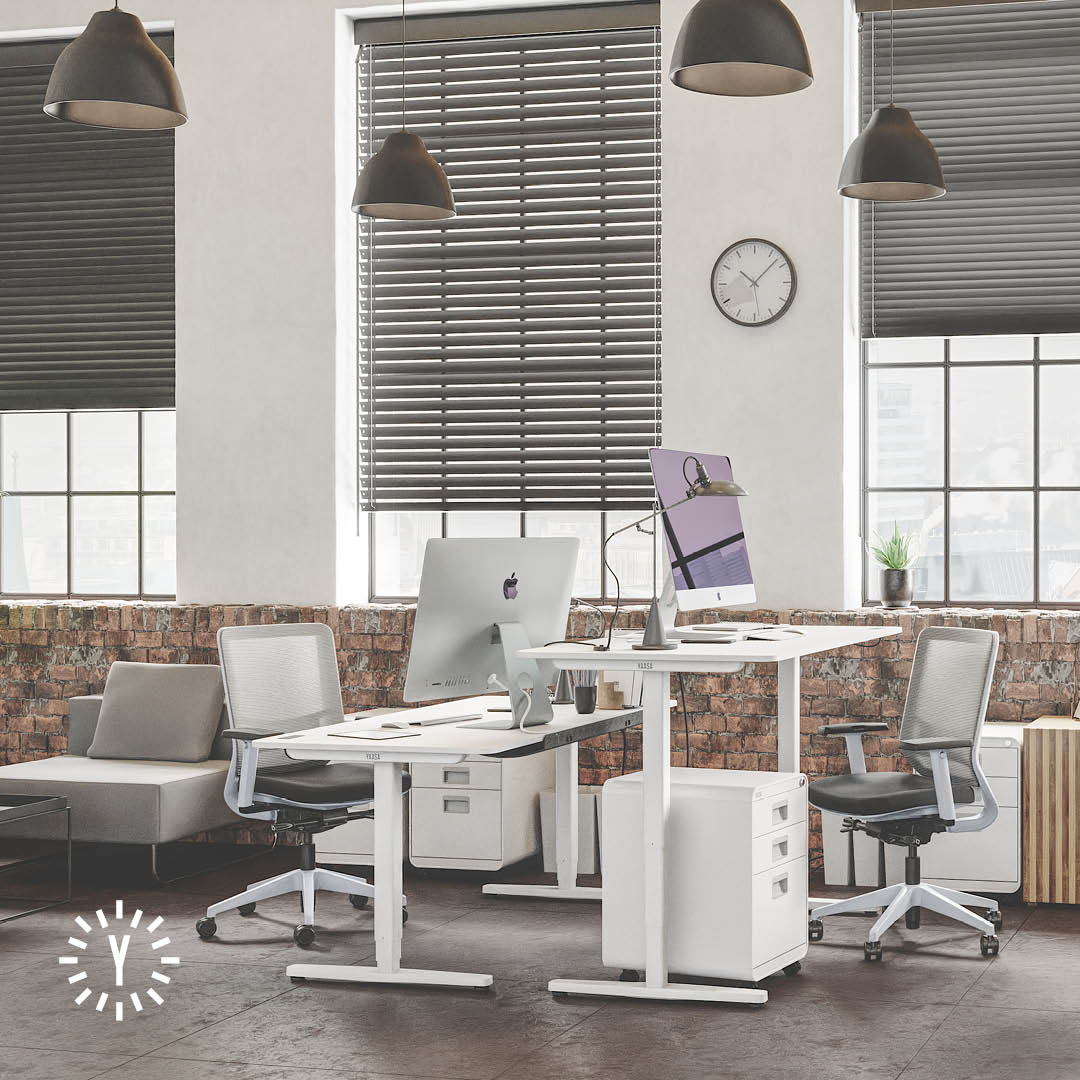
Use as much natural light as possible at the workplace
Science agrees that daylight is the healthiest light source is. It allows our eyes to see clearly without straining them.
However, there is often a lack of natural light in open-plan offices and during the darker months of the year. It is therefore recommended that in these cases office lamps and office luminaires that imitate natural daylight as closely as possible.
Lamps with so-called daylight sensors are also ideal for providing the right lighting at the workplace: they ensure consistent and uniform brightness throughout the day. As different light intensities and colors can be better for us at different times of the day, many lamps with daylight sensors also allow you to adjust the lighting individually, depending on your needs.
Discover modern office lamps with daylight sensor:
Ensure the right brightness for your workplace lighting
The optimum brightness for your workstation at your desk is a question of individual needs and external conditions.
According to laws, an office workstation with a computer usually requires an illuminance of at least 500 lux for an office workstation with a computer. This requirement is usually met by ceiling lights. If you have any doubts as to whether this minimum value is achieved in your office, talk to the person responsible for safety and ask for a light measurement. If the 500 lux is available, but you still want more light at your workplace, ask for an additional office lamp for your workplace.
The right illuminance for working depends on many different factors. These include your personal preferences, daylight, the weather, the time of day and your age. Having neither too little light nor too bright light at your workplace is important and should be taken into account.
If you have the option of using an adjustable ergonomic desk lamp or floor lamp try to set it brighter in the morning. Adjust the brightness of the lamp according to the daylight so as not to strain your eyes too much. On gloomy days, you can increase the brightness slightly. Normally, you will quickly feel what is comfortable for you. Towards evening, you should reduce the brightness again slightly.

Make sure your workplace lighting has the right color temperature
Which light color is best for working at your desk depends largely on you and your needs. Most people think of the "right" lighting in terms of brightness.
But the light color also plays an important role, as it has a significant influence on how comfortable it is for you. A distinction is made between cooler and warmer lightwhich manifests itself in the extremes of blue-white and red-gold.
The ergonomically correct light color depends on the time of day you are working or how the weather outside. The time you spend in front of the screen can also influence which light is best for you. Warmer light is recommended after long periods of screen time. In the morning, the light should contain more blue, to stimulate serotonin production and prepare you for the day. As the day progresses, you can reduce the amount of blue and switch to warmer light in the evening, so as not to impair your sleep. Warm light also has a more pleasant effect in a darker environment and reduces stress.
Combine direct light and indirect light in the workplace
Whether you should rely on direct or indirect light for lighting in the workplace depends largely on the activity and the environment. Let's first take a look at what these terms mean!
Direct light is exactly what the name says: a beam of light that directly illuminates a surface without shielding or obstructions. Typical examples are desk lamps or ceiling lights that shine directly downwards. Direct light is particularly suitable for precise work as it illuminates details well and provides plenty of brightness for a specific area. However, direct light tends to be dazzling or highly reflective, which can be perceived as unpleasant and does not exactly create a relaxed atmosphere.
Indirect light on the other hand, is a diffuse light that has a softer effect. It is often generated by LED strips, lampshades or ceiling washlights. Indirect light minimizes shadows and hard edges, making it particularly easy on the eyes. This type of lighting is often used in living or wellness areas as it creates a relaxed ambience.
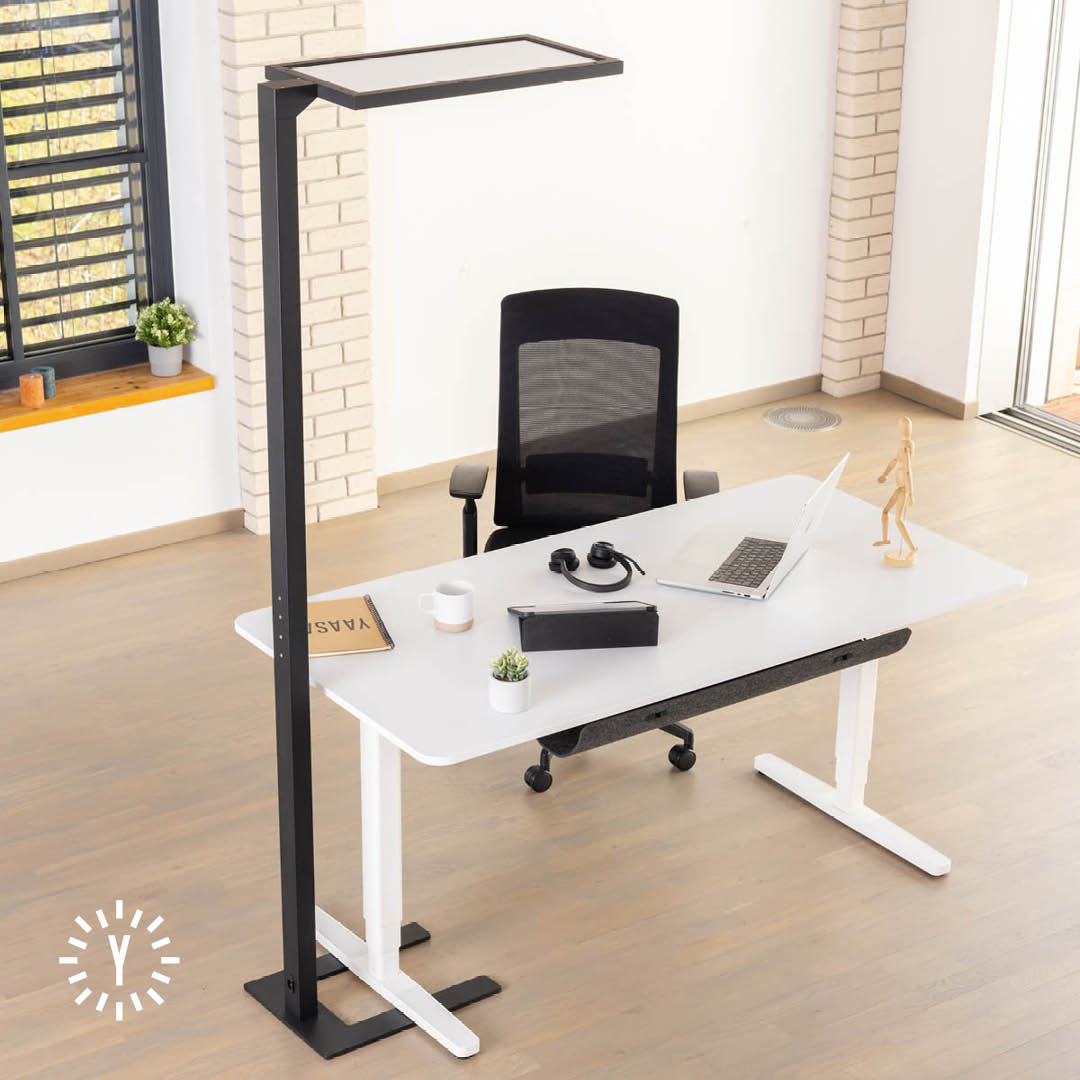
Although indirect light is very pleasant and relaxing, it should not be relied on exclusively in the workplace. Relying solely on indirect light can quickly lead to tiredness and a lack of concentration. It is therefore ideal to use a mixture of both types of light to ensure both good illumination and a pleasant working atmosphere.
Are you looking for office lamps with direct and indirect lighting functions?
Laws and regulations relating to lighting in the workplace
There are various laws and regulations that deal with the topic of "light in the workplace". In order to provide you with comprehensive information, we provide an overview of the lighting regulations for office workplaces in Germany and Austria below.
Laws and regulations on workplace lighting in Germany
Lighting in the workplace is regulated by German law in the Technical rule for workplaces "ASR A3.4", which is part of the Workplace Ordinance (ArbStättV).
German law emphasizes that daylight should be used as effectively as possible. The advantages of real daylight cannot be imitated and should therefore be fully utilized. Daylight is therefore always preferable to artificial lighting. The legal text recognizes the influence of daylight on health and well-being.
At least 10% of the room area must be illuminated by natural light. If pure daylight illumination cannot be guaranteed, the employer is obliged to illuminate the workplace artificially. to illuminate the workplace artificially. In most cases, this applies due to the weather, rooms and seasons.
German law stipulates a minimum illuminance of 500 lux for a normal desk workstation in an office. In addition, the surroundings, i.e. the rest of the office, must also be illuminated with approx. 300 lux to avoid excessive contrasts.
German law also stipulates that additional health requirementssuch as declining eyesight in old age, must be taken into account.
There is also a requirement to avoid annoying light. This includes, for example, dazzling light or flickering lamps.

Laws and regulations on light in the workplace in Austria
In Austria, there are specific legal requirements for light and lighting in the workplace. The bases for this are:
- §§ 21, 22 Employee Protection Act (ASchG)
- Workplace Ordinance (AStV)
- § 6 Display Screen Equipment Ordinance (BS-V)
The Austrian law also emphasizes that daylight should be used as much as possible. as possible. The workplace must be designed in such a way that at least 10% of the area is illuminated by natural light - for example through windows or skylights. There must also be a visual connection to the outsidewhich corresponds to at least 5% of the floor area.
Under Austrian law, additional artificial lighting at the desk is artificial lighting at the desk is mandatory. The main reason for this is that natural light is often insufficient. Artificial lighting compensates for the lack of natural light in the winter months, in cloudy weather or during early or late working hours.
Artificial lighting must be bright enough and have a neutral color temperature. This means that the light must not be too dazzling white or too warm orange. In the office, the lights must be set so that they provide reach at least 500 lux are reached.
The law also takes into account the individual needs of employees are also taken into account. For example, additional light sources are recommended for people with visual impairments, such as desk lamps that make it easier to work without dazzling and also brighten in a white or neutral tone.
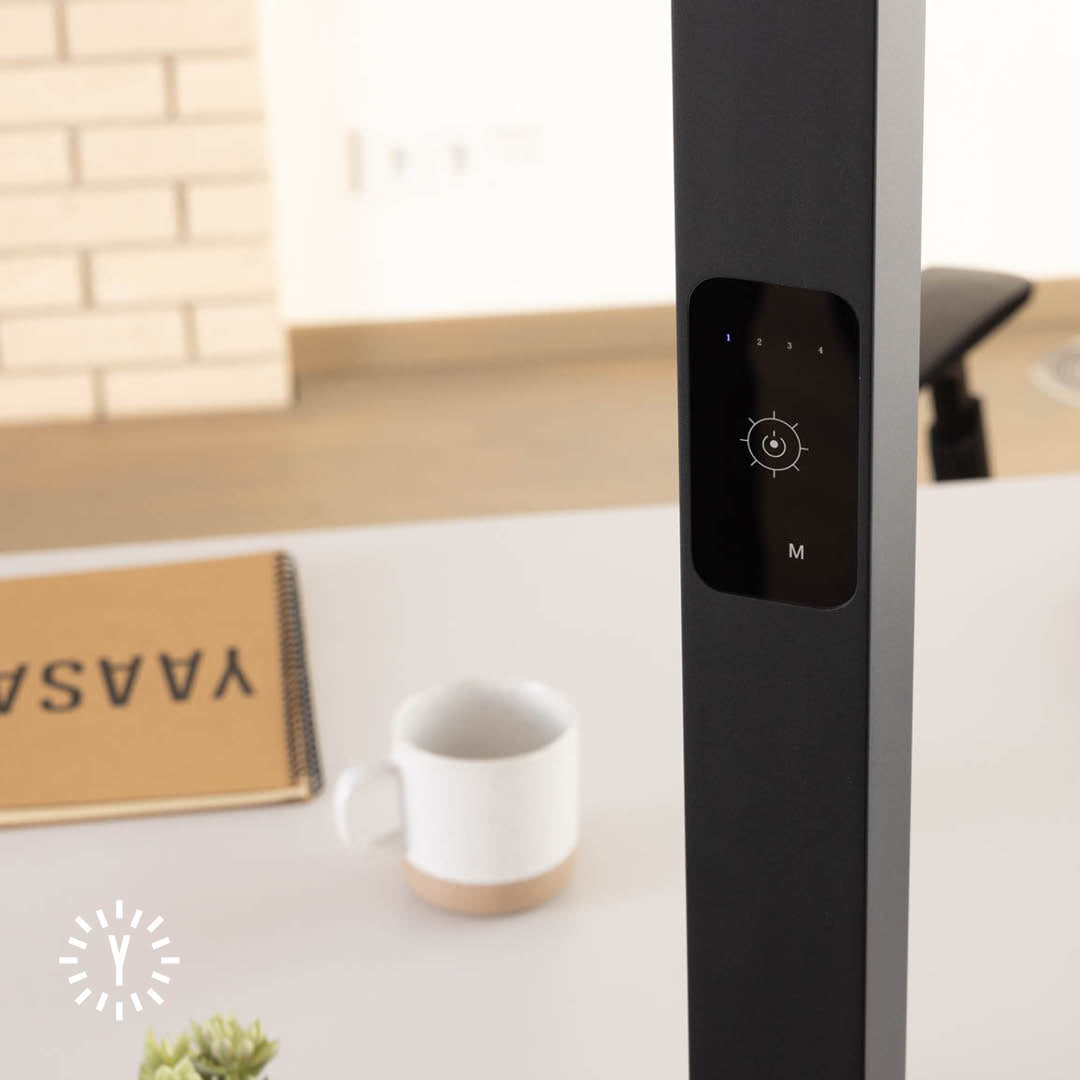
Dangers and negative effects of incorrect lighting conditions at the office workplace
The wrong lighting conditions can have a negative impact on your health, productivity and general well-being. Here we have summarized the most common consequences of inadequate or incorrect workplace lighting in the office or home office:
Light that is too bright or too dim leads to excessive eye strain. This can result in fatigue, headaches, burning eyes or blurred vision. In the long term, excessive eye strain caused by incorrect lighting conditions can also result in more serious eye problems, such as defective vision or deterioration of eyesight.
Poor lighting impairs concentration, for example by causing headaches. If the light dazzles you, is too bright or too weak, you will not be able to concentrate fully on your work. This in turn has a negative impact on your productivity. Among other things, poor lighting conditions can also lead to a negative mood and general malaise, which also affects motivation.
Excessively bright light, especially in the evening, can inhibit the production of the sleep hormone melatonin and disrupt the natural sleep-wake rhythm. This makes it difficult for you to fall asleep and can lead to general sleep disorders.
If the workplace is not well lit, you often have to adopt unfavorable postures in order to see well. If you adopt a non-ergonomic posture, this can lead to tension and neck and back pain, which can have an even greater impact on your health and well-being.
We summarize the 5 most important points about light and lighting at the workplace!
At first glance, the right light in the workplace is a science in itself. However, it is worth looking into the subject. Because with the right lighting, you can increase both your well-being and your productivity. That's why there are also corresponding legal requirements that regulate light in the workplace.
We have summarized the most important points from this blog post for you:
- How fit, comfortable and productive you feel is largely dependent on the light you are exposed to.
- In addition to brightness, the color of the light also plays an important role.
- How much and what kind of light you need depends on many factors. These include the weather, season, time of day, activity and personal preferences.
- For office work on a computer, the law stipulates at least 500 lux.
- When buying an office lamp you should make sure that you can flexibly adjust the brightness and light color.
In short: the right office lighting is crucial for your well-being and productivity and is therefore just as important for ergonomic working as your desk or office chair.
Make sure you have the right lighting at your workplace:
